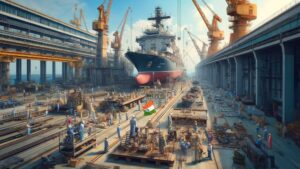Introduction
Mazagon Dock Shipbuilders Limited (MDSL), a premier shipbuilding company in India, is renowned for constructing submarines and warships for the Indian Navy and Coast Guard. This analysis provides a detailed comparison of MDSL with its primary competitors: Garden Reach Shipbuilders & Engineers (GRSE), Cochin Shipyard Limited (CSL), and Goa Shipyard Limited (GSL). The comparison covers business models, market segments, future strategies, strengths, weaknesses, profit formulas, investors, customers, and market capitalization.
Mazagon Dock Shipbuilders Limited (MDSL)
Business Model and Segments Mazagon Dock focuses on constructing submarines, destroyers, and frigates, with a significant portion of its revenue derived from defense contracts. The company also builds offshore platforms and commercial vessels.
Future Strategies MDSL aims to enhance its submarine construction capabilities and expand into new markets, including exports. The company is also investing in modernizing its infrastructure to increase efficiency and output.
Strengths and Weaknesses Strengths:
- Expertise in submarine technology.
- Strong relationship with the Indian Navy.
Weaknesses:
- High dependence on defense contracts.
- Limited diversification into commercial shipbuilding.
Profit Formula MDSL’s profitability is driven by high-margin defense contracts and cost-plus agreements that ensure stable returns.
Investors and Market Capitalization MDSL is publicly listed with significant government ownership. Its market capitalization reflects its strategic importance and stable revenue from defense contracts.
Customers Primary customers include the Indian Navy and Coast Guard, with some commercial clients in the offshore sector.
Garden Reach Shipbuilders & Engineers (GRSE)
Business Model and Segments GRSE specializes in constructing small to medium-sized warships, such as frigates, corvettes, and patrol vessels, for the Indian Navy and Coast Guard. The company also builds commercial vessels and offers ship repair services.
Future Strategies GRSE plans to modernize its shipyards and collaborate with international shipbuilders to enhance its capabilities. The company is also exploring export opportunities to diversify its revenue streams.
Strengths and Weaknesses Strengths:
- Extensive experience in warship construction.
- Strong design and engineering capabilities.
Weaknesses:
- Heavy reliance on government contracts.
- Limited presence in the commercial shipbuilding market.
Profit Formula GRSE’s profitability depends on defense contracts with cost-plus pricing, ensuring stable margins. The company also benefits from efficient project execution.
Investors and Market Capitalization GRSE is government-owned and publicly listed. Its market capitalization reflects its steady performance and strategic role in national defense.
Customers Main customers include the Indian Navy, Indian Coast Guard, and various state governments.
Cochin Shipyard Limited (CSL)
Business Model and Segments CSL has a diversified portfolio, constructing tankers, bulk carriers, passenger ships, and defense vessels. It also offers significant ship repair services, which contribute to its revenue.
Future Strategies CSL is expanding its capacity with new dry docks and enhancing its ship repair facilities. The company aims to enter the offshore renewable energy market by building specialized vessels.
Strengths and Weaknesses Strengths:
- Diversified service offerings, including shipbuilding and repair.
- Strong financial performance and consistent profitability.
Weaknesses:
- High competition in commercial shipbuilding.
- Cyclical nature of the shipping industry affects demand.
Profit Formula CSL balances its revenue through shipbuilding and high-margin ship repair services, providing steady cash flows despite industry cycles.
Investors and Market Capitalization CSL is publicly traded with significant government ownership. Its robust financial health and strategic initiatives are reflected in its market capitalization.
Customers CSL serves a diverse customer base, including the Indian Navy, commercial shipping companies, and international clients.
Goa Shipyard Limited (GSL)
Business Model and Segments GSL focuses on building medium-sized vessels for defense and commercial purposes. It is known for constructing fast patrol vessels, interceptors, and offshore patrol vessels.
Future Strategies GSL aims to upgrade its infrastructure to build more complex and larger vessels. The company is also exploring international markets for exports and joint ventures.
Strengths and Weaknesses Strengths:
- Niche expertise in medium-sized defense vessels.
- Strategic location with access to the Arabian Sea.
Weaknesses:
- Smaller scale compared to other major Indian shipbuilders.
- Limited diversification in product offerings.
Profit Formula GSL’s profitability is driven by specialized defense contracts, leveraging its niche expertise in medium-sized vessels.
Investors and Market Capitalization GSL is government-owned and not publicly listed, which limits its exposure to market volatility but restricts its access to capital markets.
Customers The Indian Navy and Coast Guard are GSL’s primary customers, with some business from commercial operators and international clients.
Comparative Analysis
Market Segments and Customer Base
- Mazagon Dock: Focuses on submarines and large warships, primarily serving the Indian Navy.
- GRSE: Specializes in small to medium-sized warships and auxiliary vessels, serving the Indian Navy, Coast Guard, and state governments.
- CSL: Diversified portfolio including commercial and defense vessels, with significant ship repair services, serving a global customer base.
- GSL: Focuses on medium-sized defense vessels, primarily serving the Indian Navy and Coast Guard.
Future Strategies
- Mazagon Dock: Expanding capabilities in submarine construction and exploring new markets.
- GRSE: Modernization and international collaborations.
- CSL: Capacity expansion and entry into offshore renewable energy markets.
- GSL: Infrastructure enhancement and export market exploration.
Strengths and Weaknesses
- Mazagon Dock: Strength in submarine technology, but limited diversification.
- GRSE: Strong in warship design but dependent on government contracts.
- CSL: Diverse offerings and strong financials but faces high competition.
- GSL: Niche expertise but smaller scale.
Profit Formulas
- Mazagon Dock: High-margin defense contracts.
- GRSE: Cost-plus defense contracts.
- CSL: Balance of shipbuilding and repair services.
- GSL: Specialized defense vessel contracts.
Market Capitalization and Investors
- Mazagon Dock: Publicly listed with significant government ownership.
- GRSE: Government-owned, publicly listed.
- CSL: Publicly traded with robust market capitalization.
- GSL: Government-owned, not publicly listed.
Conclusion
Mazagon Dock faces stiff competition from GRSE, CSL, and GSL, each with unique strengths and strategies. While Mazagon Dock excels in submarine construction, its competitors have diversified portfolios and strategic initiatives aimed at expansion and modernization. Understanding these dynamics is crucial for stakeholders and investors evaluating the Indian shipbuilding industry.




